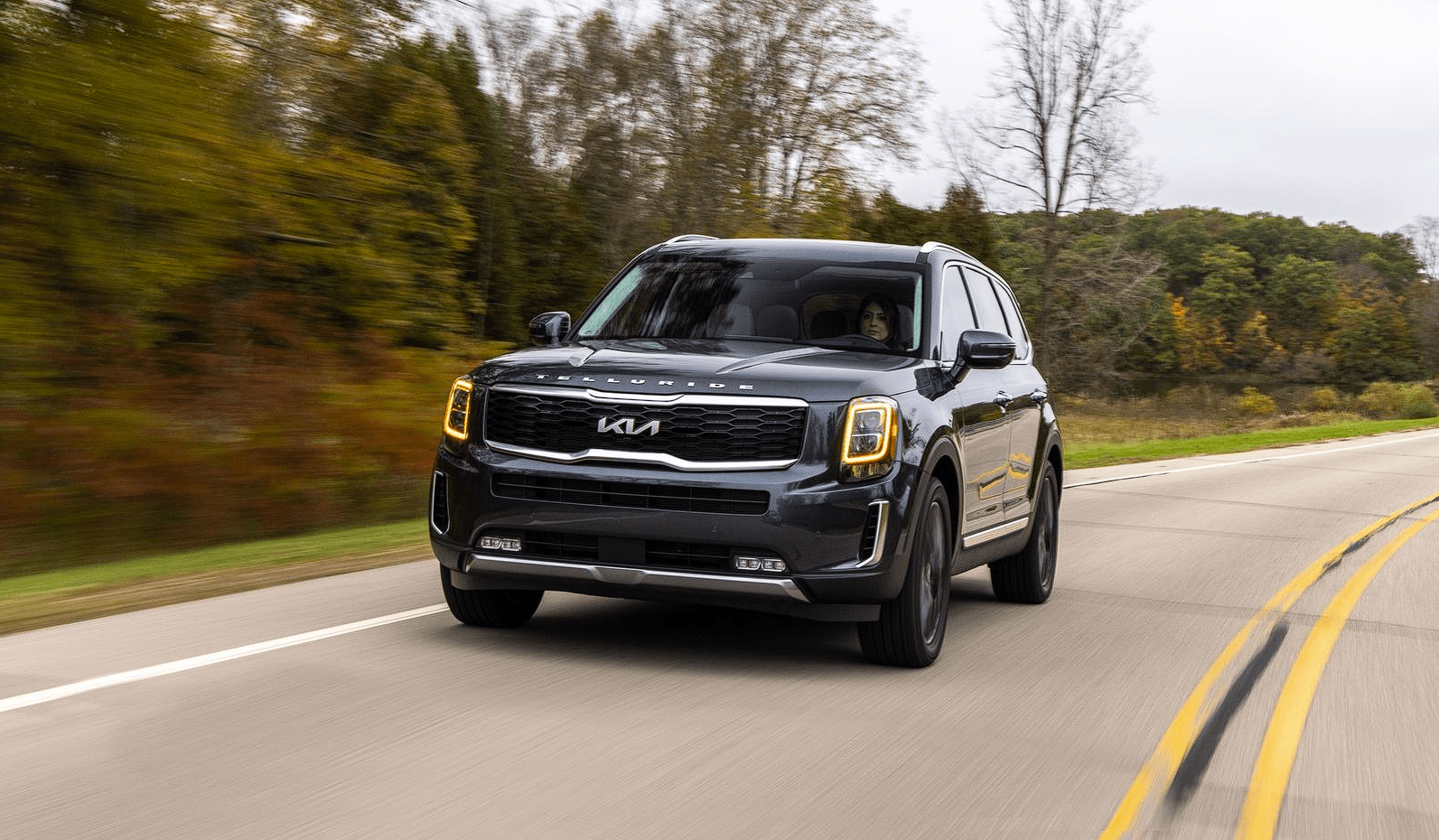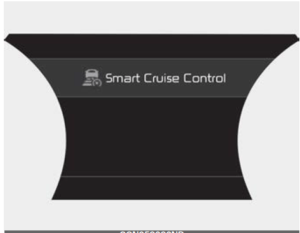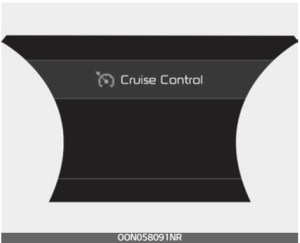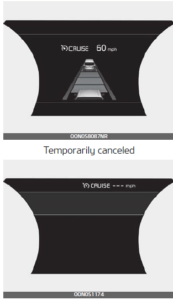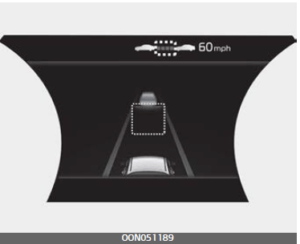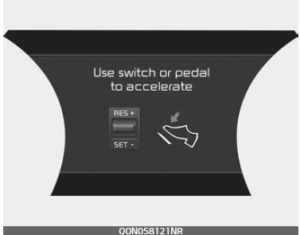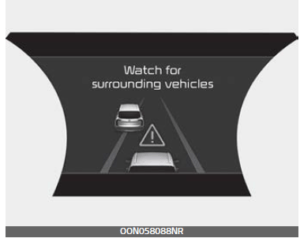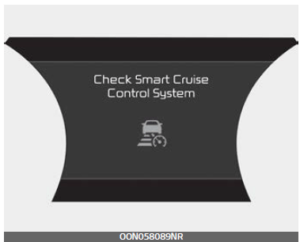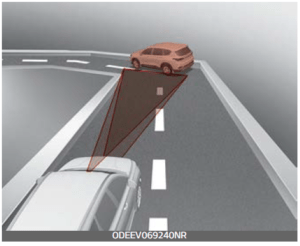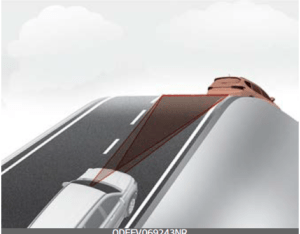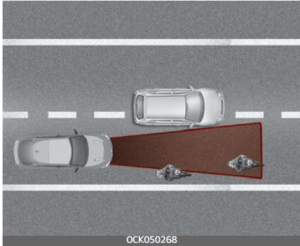Kia Telluride 2022 Smart Cruise Control (SCC)
Smart Cruise Control (SCC), a new feature on the 2022 Kia Telluride, makes driving smarter and more adaptable. This shows that Kia is still committed to making driving easier and safer. Using advanced sensors and radar technology to keep an eye on the traffic in real-time, this system goes above and beyond regular cruise control. SCC stays at a set speed, but it also changes that speed automatically to keep a safe distance between itself and the car in front of it. If traffic slows down or another car cuts into Telluride’s lane, SCC can smoothly slow down and speed up, keeping the space between the cars the same and eliminating the need to make constant manual speed changes. This makes driving less stressful and more relaxing, especially on long highway trips or in traffic that comes and goes. The 2022 Telluride’s Smart Cruise Control shows how committed Kia is to new ideas. This makes it a great choice for SUV drivers who want both comfort and safety.
2023 Kia Telluride Specs, Price, Features and Mileage (Brochure)
Smart Cruise Control (SCC)
Smart Cruise Control allows you to program the vehicle to maintain constant speed and distance detecting the vehicle ahead without depressing the accelerator or brake pedal
Detecting sensor

[1]: Front view camera, [2]: Front radar
The front view camera and front radar are used as a detecting sensor to detect front vehicles.
Refer to the picture above for the detailed location of the detecting sensor.
CAUTION
Always keep the front view camera and front radar in good condition to maintain optimal performance of Smart Cruise Control.
Smart Cruise Control Settings Setting features
To turn on Smart Cruise Control

- Press the Driving Assist button, to turn the function on. The CRUISE indicator in the instrument cluster will illuminate.
- Accelerate to the desired speed. The set speed can be set as follows:
- 20 mph (30 km/h) ~ 100 mp
- Push the SET- switch down, and release it at the desired speed. The set speed and vehicle-to-vehicle distance on the LCD screen will illuminate.
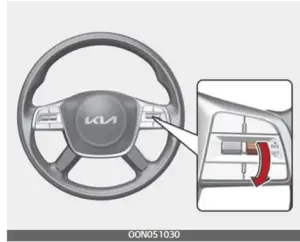
- Release the accelerator pedal. The desired speed will automatically be maintained. If there is a vehicle in front of you, the speed may decrease to maintain the distance to the vehicle ahead. On a steep grade, the vehicle may slow down or speed up slightly while going uphill or downhill.
NOTICE
Vehicle speed may decrease on an upward slope and increase on a downward slope.
To set vehicle distance
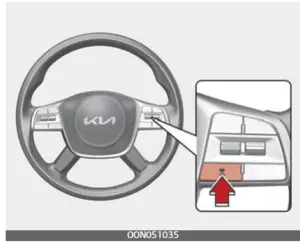
Each time the vehicle distance but-ton is pressed, the vehicle distance changes as follows:
NOTICE
- If you drive at 56 mph (90 km/h), the distance is maintained as follows:
- Distance 4 – approximately 172 ft. (52.5 m)
- Distance 3 – approximately 130 ft. (40 m)
- Distance 2 – approximately 106 ft. (32.5 m)
- Distance 1 – approximately 82 ft. (25 m)
- The distance is set to the last set distance when the engine is restarted, or when Smart Cruise Control was temporarily canceled.
To increase speed
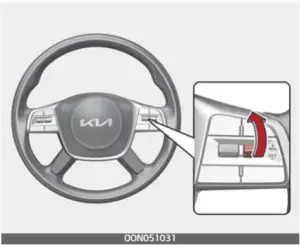
- Push the RES+ switch up, and release it immediately. The cruising speed will increase by 1 mph (1 km/h) each time the switch is operated in this manner.
- Push the RES+ switch up, and hold it while monitoring the set speed on the cluster. The cruising speed will increase by 5 mph or 10 km/h each time act the switch is operated in this manner. Release the switch when the desired speed is shown, and the vehicle will accelerate to that speed. You can set the speed to 100 mph (160 km/h).
WARNING
Check the driving condition before using the RES+ switch. Driving speed may sharply increase when you push up and hold the RES+ switch.
To decrease speed
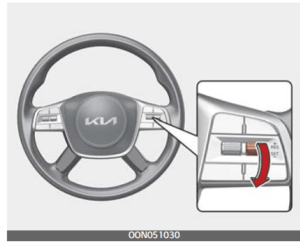
- Push the SET- switch down, and release it immediately. The cruising speed will decrease by 1 mph (1 km/h) each time the switch is operated in this manner.
- Push the SET- switch down, and hold it while monitoring the set speed on the cluster. The cruising speed will decrease by 5 mph or 10 km/h each time the switch is operated in this manner.
- Release the switch at the speed you want to maintain. You can set the speed to 20 mph (30 km/h).
To temporarily cancel Smart Cruise Control
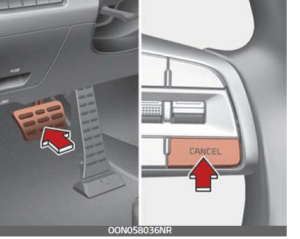
Press the CANCEL button or depress the brake pedal to temporarily cancel Smart Cruise Control.
To resume Smart Cruise Control
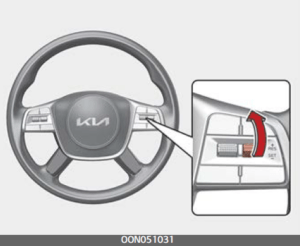
- If any method other than the RES+ or SET- switch was used to cancel cruising speed and Smart Cruise Control is still activated, the set speed will automatically resume when you push the RES+ or SET- switch up or down.
- If you push the RES+ switch up, the speed will resume to the recently set speed. However, if vehicle speed drops below 5 mph (10 km/h), it will resume when there is a vehicle in front of your vehicle.
NOTICE
Always check the road conditions when you push the switch up (to RES+) to resume speed.
To turn off Smart Cruise Control
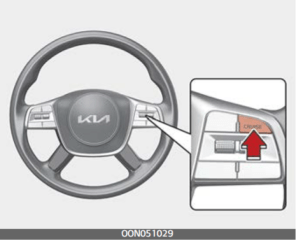
Press the Driving Assist button to turn Smart Cruise Control off.
To adjust the sensitivity of Smart Cruise Control SCC Reaction
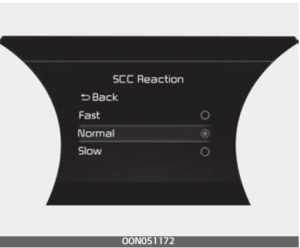
The sensitivity of vehicle speed when following the front vehicle to maintain the set distance can be adjusted. Go to the User Settings → Driver Assistance → SCC Reaction → Fast/Normal/Slow. You may select one of the three stages you prefer.
Converting to Cruise Control mode
The driver may choose to only use the cruise control mode (speed control function) by doing as follows:
- Turn Smart Cruise Control on (the cruise indicator light will be on but the function will not be activated).
- Push and hold the vehicle distance button for more than 2 seconds.
- Choose between “Smart Cruise Control” and “Cruise Control”. When the function is canceled using the Driving Assist button or the Driving Assist button is used after the vehicle is turned on, the Smart Cruise Control will turn on.
Warning Volume
With the ENGINE START/STOP button in the ON position, press the MODE button ( ) several times on the
steering wheel until the User Settings menu appears on the LCD display. Select Driver Assistance → Warning Volume to change the warning volume to High, Medium, Low or Off for Smart Cruise Control.
If you change the Warning Volume, the Warning Volume of other Driver Assistance systems may change.
NOTICE
If the engine is restarted, Warning Volume will maintain the last setting.
2023 Kia Telluride Specs, Price, Features and Mileage (Brochure)
Smart Cruise Control Operation
Operating conditions
Smart Cruise Control will operate when the following conditions are satisfied.
Basic function
- The gear is in D (Drive)
- The drivers door is closed
- EPB (Electronic Parking Brake) is not applied
- Your vehicle speed is within the operating speed range
5~110 mph (10~170 km/h): when there is no vehicle in front
0~110 mph (0~170 km/h): when there is a vehicle in front - ESC (Electronic Stability Control),
TCS (Traction Control System) or ABS is on - ESC (Electronic Stability Control), TCS (Traction Control System) or ABS is not controlling the vehicle
- Engine rpm is not in the red zone
- Forward Collision-Avoidance Assist brake control is not operating
- ISG system is not operating
NOTICE
At a stop, if there is a vehicle in front of your vehicle, the function will turn on when the brake pedal is depressed.
Smart Cruise Control Display and Control
Basic function
Operating
You can see the status of the Smart Cruise Control operation in the Driv-ing Assist view on the cluster.
To temporarily accelerate
If you want to speed up temporarily when Smart Cruise Control is on, depress the accelerator pedal for a certain amount. While depressing the accelerator pedal for a certain amount, the set speed will blink on the cluster. However, if the accelerator pedal is insufficiently depressed, the vehicle may slow down.
WARNING
Be careful when accelerating temporarily, because the speed is not controlled automatically even if there is a vehicle in front of you.
Smart Cruise Control temporarily canceled
Smart Cruise Control will be temporarily canceled automatically when:
- The vehicle speed is above 110 mph (170 km/h)
- The vehicle is stopped for a certain period of time
- The accelerator pedal is continuously depressed for a certain period of time
- The conditions for Smart Cruise Control to operate is not satisfied
If Smart Cruise Control is temporarily canceled, the ‘Smart Cruise Control canceled’ warning message will appear on the cluster, and an audible warning will sound to warn the driver.
WARNING
When Smart Cruise Control is temporarily canceled, distance with the front vehicle will not be maintained. Always have your eyes on the road while driving, and if necessary, depress the brake pedal to reduce your driving speed in order to maintain a safe distance.
Smart Cruise Control conditions not satisfied
If the Driving Assist button, RES+, SET- switch is pushed when Smart Cruise Control operating conditions are not satisfied, the Smart Cruise Control conditions not met will appear on the cluster, and an audible warning will sound.
In traffic situation
In traffic, your vehicle will stop if the vehicle ahead of you stops. Also, if the vehicle ahead of you starts moving, your vehicle will start as well. In addition, after the vehicle has stopped and a certain time have passed, the Use switch or pedal to accelerate message will appear on the cluster. Depress the accelerator pedal or push the RES+ switch up or push the SET- switch down to start driving.
Warning road conditions ahead
In the following situation, the ‘Watch for surrounding vehicles’ warning message will appear on the cluster, and an audible warning will sound to warn the driver of road conditions ahead.
The vehicle in front disappears when Smart Cruise Control maintains the distance with the vehicle ahead while driving in low speed.
WARNING
Always pay attention to vehicles or objects that may suddenly appear in front of you, and if necessary, depress the brake pedal to reduce your driving speed in order to maintain a safe distance.
Collision Warning
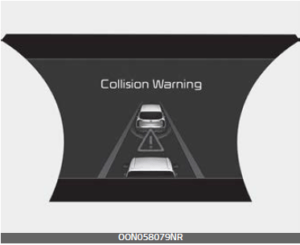
While Smart Cruise Control is operating, when the collision risk with the vehicle ahead is high, the ‘Collision Warning’ warning message will appear on the cluster, and an audible warning will sound to warn the driver. Always have your eyes on the road while driving, and if necessary, depress the brake pedal to reduce your driving speed in order to maintain a safe distance.
WARNING
- In the following situations, Smart Cruise Control may not warn the driver of a collision.
- The distance from the front vehicle is near, or the vehicle speed of the other vehicle is faster or similar with your vehicle
- The speed of the front vehicle is very slow or is at a standstill
- The accelerator pedal is depressed right after Smart Cruise Control is turned on
WARNING
Take the following precautions when using Smart Cruise Control :
- Smart Cruise Control does not substitute for proper and safe driving. It is the responsibility of the driver to always check the speed and distance to the vehicle ahead.
- Smart Cruise Control may not recognize unexpected and sudden situations or complex driving situations, so always pay attention to driving conditions and control your vehicle speed.
- Keep Smart Cruise Control off when the function is not in use to avoid inadvertently setting a speed.
- Do not open the door or leave the vehicle when Smart Cruise Control is operating, even if the vehicle is stopped.
- Always be aware of the selected
- Keep a safe distance according to road conditions and vehicle speed. If the vehicle distance is too close during high-speed driving, a serious collision may result.
- When maintaining distance with the vehicle ahead, if the front vehicle disappears, Smart Cruise Control may suddenly accelerate to the set speed. Always be aware of unexpected and sudden situations from occurring.
- Vehicle speed may decrease on an upward slope and increase on a downward slope.
- Always be aware of situations such as when a vehicle cuts in suddenly.
- When you are towing a trailer or another vehicle, we recommend that Smart Cruise Control is turned off due to safety reasons.
- Turn off Smart Cruise Control when your vehicle is being towed.
- Smart Cruise Control may not operate normally if interfered by strong electromagnetic waves.
- Smart Cruise Control may not detect an obstacle in front and lead to a collision. Always look ahead cautiously to prevent unexpected and sudden situations from occurring.
- Vehicles moving in front of you with frequent lane changes may cause a delay in the function’s reaction or may cause the function to react to a vehicle actually in an adjacent lane. Always drive cautiously to prevent unexpected and sudden situations from occurring.
- Always be aware of the surroundings and drive safely, even though a warning message does not appear or an audible warning does not sound.
- If any other function warning message is displayed or a warning sound is generated, a Smart Cruise Control warning message may not be displayed and warning sound may not be generated.
- You may not hear the warning sound of Forward Collision-Avoidance Assist if the surrounding is noisy.
- The vehicle manufacturer is not responsible for any traffic violations or accidents caused by the driver.
- Always set the vehicle speed under the speed limit in your state.
NOTICE
- Smart Cruise Control may not operate in a few seconds after the vehicle is started or the front view camera or front radar is initialized.
- You may hear a sound when the brake is controlled by Smart Cruise Control.
Smart Cruise Control Malfunction and Limitations
Smart Cruise Control malfunction
The message will appear when Smart Cruise Control is not functioning normally. In this case, take your vehicle to an authorized Kia dealer and have the function checked.
Smart Cruise Control disabled
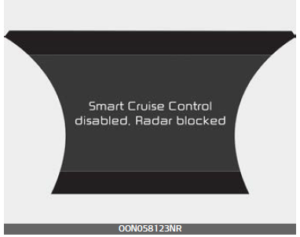
When the front radar cover or sensor is covered with snow, rain, or foreign matters, it can reduce the detecting performance and temporarily limit or disable Smart Cruise Control.
If this occurs the Smart Cruise Control is disabled. Radar blocked. warning message and warning lights will illuminate on the cluster.
Smart Cruise Control will operate normally when such snow, rain or foreign matter is removed.
WARNING
Even though the warning message does not appear on the cluster, Smart Cruise Control may not properly operate.
CAUTION
Smart Cruise Control may not properly operate in an area (e.g. open terrain), where any substance are not detected after turning ON the engine.
Limitations of Smart Cruise Control
Smart Cruise Control may not operate normally, or the function may operate unexpectedly under the following circumstances:
- The detecting sensor or the surroundings are contaminated or damaged
- Washer fluid is continuously sprayed, or the wiper is on
- The camera lens is contaminated due to tinted, filmed or coated windshield, damaged glass, or stuck of foreign matters (sticker, bug, etc.) on the glass
- Moisture is not removed or frozen on the windshield
- The field of view of the front view camera is obstructed by sun glare
- Street light or light from an oncoming vehicle is reflected on the wet road surface, such as a puddle on the road
- The temperature around the front view camera is high or low
- An object is placed on the dashboard
- The surrounding is very bright
- The surrounding is very dark, such.as in a tunnel, etc.
- The brightness changes suddenly, for example when entering or exiting a tunnel
- The brightness outside is low, and the headlamps are not on or are not bright
- Driving in heavy rain or snow, or thick fog
- Driving through steam, smoke or shadow
- Only part of the vehicle is detected
- The vehicle in front has no tail lights, tail lights are located unusually, etc.
- The brightness outside is low, and the tail lamps are not on or are not bright
- The rear of the front vehicle is small or does not look normal (i.e. tilted, overturned, etc.)
- The front vehicle’s ground clearance is low or high
- Your vehicle is being towed
- A vehicle suddenly cuts in front
- Driving through a tunnel or railroad bridge
- A material is near that reflects very well on the front radar, such as a guardrail, nearby vehicle, etc.
- The bumper around the front radar is impacted, or damaged or the front radar is out of position
- The temperature around the front radar is high or low
- Driving in large areas where there are few vehicles or structures (i.e. desert, meadow, suburb, etc.)
- The vehicle in front is made of material that does not reflect on the front radar
- Driving near a highway (or motorway) interchange or tollgate
- Driving on a slippery surface due to snow, water puddles, ice, etc. Driving on a curved road
- The vehicle in front is detected late
- The vehicle in front is suddenly blocked by an obstacle
- The vehicle in front suddenly changes lane or suddenly reduces the speed
- The vehicle in front is bent out of shape
- The front vehicle’s speed is fast or slow
- With a vehicle in front, your vehicle changes lanes at low speed
- The vehicle in front is covered with snow
- You are driving unstably
- You are on a roundabout and the vehicle in front is not detected
- You are continuously driving in a circle
- Driving in a parking lot
- Driving through a construction area, unpaved road, partially paved road, uneven road, speed bumps, etc.
- Driving on an inclined road, curved road, etc.
- Driving through a roadside with trees or streetlights
- The adverse road conditions cause excessive vehicle vibrations while driving
- Your vehicle height is low or high due to heavy loads, abnormal tire pressure, etc.
- Driving through a narrow road where trees or grass are overgrown
- There is interference by electromagnetic waves, such as driving in an area with strong radio waves or electrical noise
- Driving on a curved road
On curves, Smart Cruise Control may not detect a vehicle in the same lane, and may accelerate to the set speed. Also, vehicle speed may rapidly decrease when the vehicle ahead is detected suddenly.
Select the appropriate set speed on curves and apply the brake pedal or accelerator pedal according to the road and driving conditions ahead.
Your vehicle speed can be reduced due to a vehicle in the adjacent lane.
Apply the accelerator pedal and select the appropriate set speed.
Check to be sure that the road conditions permit safe operation of Smart Cruise Control.
- Driving on a sloped road
During uphill or downhill driving, Smart Cruise Control may not detect a moving vehicle in your lane, and cause your vehicle to accelerate to the set speed. Also, vehicle speed will rapidly decrease when the vehicle ahead is detected suddenly.
Select the appropriate set speed on inclines and apply the brake pedal or accelerator pedal according to the road and driving conditions ahead.
- Changing lanes
[A]: Your vehicle, [B]: Lane changing vehicle
When a vehicle moves into your lane from an adjacent lane, it cannot be detected by the sensor until it is in the sensor’s detection range.
Smart Cruise Control may not immediately detect the vehicle when the vehicle changes lanes abruptly. In this case, you must maintain a safe braking distance, and if necessary, depress the brake pedal to reduce your driving speed in order to maintain a safe distance. - Detecting vehicle
In the following cases, some vehicles in your lane cannot be detected by the sensor:
- Vehicles offset to one side
- Slow-moving vehicles or sudden decelerating vehicles
- Oncoming vehicles
- Stopped vehicles
- Vehicles with small rear profiles, such as trailers
- Narrow vehicles, such as motorcycles or bicycles
- Special vehicles
- Animals and pedestrians
In the following cases, the vehicle in front cannot be detected by the sensor:
- Vehicles with higher clearance or vehicles carrying loads that stick out of the back of the vehicle
- Vehicles that has the front lifted due to heavy loads
- You are steering your vehicle
- Driving on narrow or sharply curved roads
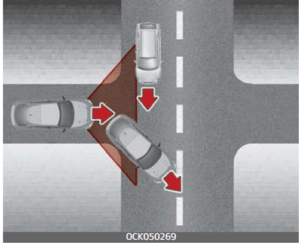
When a vehicle ahead disappears at an intersection, your vehicle may accelerate. Always pay attention to road and driving conditions while driving.
When a vehicle in front of you merges out of the lane, Smart Cruise Control may not immediately detect the new vehicle that is now in front of you. Always pay attention to road and driving conditions while driving.
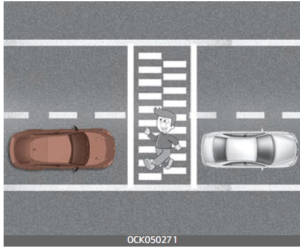
This device complies with Part 15 of the FCC rules.
Operation is subject to the following three conditions:
- This device may not cause harmful interference, and
- This device must accept any interference received, including interference that may cause undesired operation.
- Changes or modifications not expressly approved by the party responsible for compliance could void the user’s authority to operate the device.
Radiofrequency radiation exposure information:
This equipment complies with FCC radiation exposure limits set forth for an uncontrolled environment. This equipment should be installed and operated with minimum distance of 8 in (20 cm) between the radiator (antenna) and your body.
This transmitter must not be co-located or operating in conjunction with any other antenna or transmitter.
Q&A
What is Smart Cruise Control (SCC) on the Kia Telluride 2022?
Smart Cruise Control (SCC) is an advanced safety feature available on the Kia Telluride 2022 that helps drivers maintain a safe following distance while cruising on the highway.
How does the SCC system work on the Telluride?
The SCC system uses radar and camera sensors to detect the distance and speed of the vehicle in front of the Telluride. The system can then adjust the vehicle’s speed to maintain a safe following distance, even in heavy traffic.
Can drivers set the desired speed and following distance with SCC on the Telluride?
Yes, the driver can set the desired speed and following distance, and the SCC system will automatically adjust the vehicle’s speed to maintain that distance.
Does the SCC system on the Telluride also feature a Forward Collision-Avoidance Assist (FCA) system?
Yes, the SCC system on the Telluride features a Forward Collision-Avoidance Assist (FCA) system, which can detect a potential collision with the vehicle in front and apply the brakes if necessary to avoid or mitigate a collision.
Can the SCC system bring the Telluride to a complete stop if necessary?
Yes, the SCC system on the Telluride can bring the vehicle to a complete stop if necessary, and then resume the set speed once traffic starts moving again.
How does the SCC system on the Telluride help reduce driver fatigue and stress?
The SCC system on the Telluride can bring the vehicle to a complete stop in stop-and-go traffic, reducing driver fatigue and stress.
Is the SCC system a standard feature on all Telluride trims?
Yes, the Smart Cruise Control (SCC) system is a standard feature on all Telluride trims.
Can the SCC system be turned on and off on the Telluride?
Yes, the SCC system can be turned on and off using controls on the steering wheel.
Does the SCC system work at all speeds on the Telluride?
No, the SCC system on the Telluride works only at highway speeds.
Is there a minimum following distance that the SCC system can maintain on the Telluride?
Yes, there is a minimum following distance that the SCC system can maintain on the Telluride.
Does the SCC system on the Telluride provide an alert if it detects a potential collision?
Yes, the SCC system on the Telluride can provide an audible and visual alert if it detects a potential collision.
Can the SCC system on the Telluride adjust the vehicle’s speed if the vehicle in front is moving faster than the set speed?
No, the SCC system on the Telluride can only adjust the vehicle’s speed to maintain a safe following distance based on the set speed.
Is the SCC system on the Telluride affected by weather conditions?
The SCC system on the Telluride may be affected by severe weather conditions such as heavy rain, snow, or fog.
Is the SCC system on the Telluride a substitute for attentive driving?
No, the SCC system on the Telluride is not a substitute for attentive driving and should be used as a supplemental safety feature.
Does the SCC system on the Telluride work in all driving conditions?
No, the SCC system on the Telluride works best in highway driving conditions with a clear view of the road ahead.
Useful Link
View Full User Guide: Kia Telluride 2022 User Guide
Download Manuals: https://owners.kia.com/content/owners/en/manuals.html
2023 Kia Telluride Specs, Price, Features and Mileage (Brochure)

